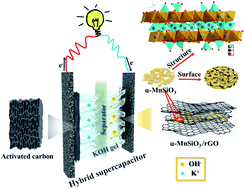Ammonia-etching-assisted nanotailoring of manganese silicate boosts faradaic capacity for high-performance hybrid supercapacitors†
Abstract
Nanotailoring of active faradaic electrode materials with enhanced surface chemical reactivity is among the most efficient strategies of securing fast reaction kinetics in the hybrid supercapacitor application. Herein, an ammonia-etching-assisted nanotailoring of α-phase manganese silicate (nt-MnSiO3) with an average particle size of about 20 nm is purposely developed to disruptively promote its electrochemical faradaic reaction kinetics. The as-synthesized nt-MnSiO3 exhibits a 3.55-times higher faradaic capacitance than the common yolk–shell counterpart at 0.5 A g−1. After being wrapped with reduced graphene oxide (rGO), the electrochemical performance of nt-MnSiO3/rGO is further enhanced with a specific capacitance of 860 F g−1 at 0.5 A g−1 and a capacitance retention of 80% after 5000 cycles. Integrating them with activated carbon into a hybrid supercapacitor device (nt-MnSiO3/rGO//AC) demonstrates an impressive areal capacitance of 816 mF cm−2 at 1 mA cm−2, and an ultrahigh energy density of 1.633 W h m−2 (40.8 W h kg−1) at a large power density of 1.5 W m−2 (37.5 W kg−1) even under bending conditions. The present work provides a guideline to disruptively improve the faradaic capacity of electrode materials for high-performance supercapacitors.

- This article is part of the themed collection: 2019 Sustainable Energy and Fuels HOT Articles


 Please wait while we load your content...
Please wait while we load your content...